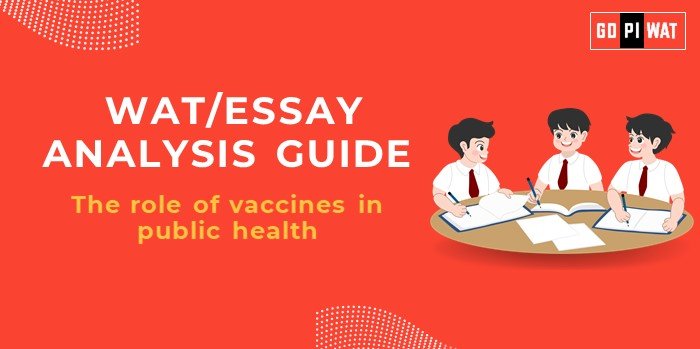📝 Written Ability Test (WAT) / Essay Analysis Guide
🌍 Understanding the Importance of Vaccines in Public Health
Vaccines are a fundamental component of public health strategies, effectively preventing the spread of infectious diseases and reducing mortality rates. Their development and distribution are critical in managing both endemic and pandemic situations, thereby safeguarding global health and economic stability.
📅 Effective Planning and Writing
- ⏱️ Planning: 5 minutes
- ✍️ Writing: 20 minutes
- 🔍 Review: 5 minutes
Preparation Tips:
- 📊 Identify recent statistics on vaccination impact.
- 🧑🤝🧑 Note key stakeholders involved in vaccination efforts.
- ⚠️ Be aware of current challenges and advancements in vaccine development and distribution.
💡 Introduction Techniques for Essays
- Contrast Approach: “While vaccines have eradicated diseases like smallpox, rising vaccine hesitancy poses a significant risk to public health, threatening to reverse decades of progress.”
- Solution-Based Approach: “As infectious diseases evolve and new health threats emerge, vaccines provide a crucial line of defense. Ensuring equitable access and addressing misinformation are essential to maximizing their impact.”
- Timeline Introduction: “From smallpox eradication in 1980 to the rapid development of COVID-19 vaccines in 2020, vaccination programs highlight how scientific innovation and collaboration can transform public health outcomes globally.”
🧱 Structuring the Essay Body
1. 🏆 Achievements
Topic Sentence: “Vaccines have been remarkably successful in eradicating or controlling major diseases worldwide.”
Evidence: Mention the eradication of smallpox and the near-eradication of polio.
Impact Analysis: Describe how vaccines reduce healthcare costs, enhance life expectancy, and contribute to economic stability.
2. ⚠️ Challenges with Comparative Analysis
Problem Statement: “Despite their success, vaccines face considerable challenges related to public mistrust, logistical issues, and access inequalities.”
Data Evidence: Reference statistics on vaccine hesitancy, especially in high-income countries, and coverage gaps in low-income regions.
Case Study: Discuss how vaccine hesitancy has led to measles outbreaks in Europe or challenges in COVID-19 vaccine distribution.
Implications: Explain how these issues impact global health, resulting in outbreaks and straining healthcare resources.
3. 🔭 Future Outlook
Current Status: Describe the advancements in vaccine technology, such as mRNA vaccines, and the ongoing research in universal vaccines.
Global Comparison: Highlight successful vaccination models in countries like Rwanda and Singapore, which have achieved high vaccination coverage through strong health infrastructure.
Recommendations: Suggest steps to increase vaccine accessibility, improve public education, and strengthen global partnerships to address emerging infectious diseases.
🔚 Concluding Effectively
- Balanced Conclusion: “While vaccines have transformed global health, ensuring their benefits reach all populations will require overcoming hesitancy, improving access, and enhancing public awareness. The future of public health depends on addressing these challenges collectively.”
- Future-Oriented Conclusion: “Vaccines are essential in protecting global health and economic stability. By advancing vaccine technology and expanding distribution, we can better prepare for future pandemics and foster a healthier world for all.”
🔍 Analyzing Successes and Shortcomings
1. Key Achievements:
- 🌍 Reduction of preventable diseases globally.
- 💰 Economic benefits through cost savings and improved workforce productivity.
- 🤝 Strong global collaboration in disease control, exemplified by COVID-19 vaccine rollouts.
2. Ongoing Challenges:
- 🛑 Vaccine hesitancy influenced by misinformation and cultural beliefs.
- 🚧 Access issues, particularly in low-income and remote areas.
- ⚖️ Inequity in distribution, as seen in the disparities during the COVID-19 vaccine rollout.
3. Global Context:
- 📈 Compare immunization success in high-vaccination countries (e.g., Scandinavian countries with high trust in public health) against those facing hesitancy challenges (e.g., France, the U.S.).
- 🌍 Highlight effective models from low-income regions, such as the MenAfriVac campaign in Africa.
💼 Recommendations for Sustainable Progress
- 📢 Public Education Campaigns: Implement initiatives to educate the public about vaccine safety, efficacy, and the dangers of misinformation, potentially integrating trusted local leaders to reach diverse communities.
- 🏥 Infrastructure Investment: Strengthen healthcare systems to improve vaccine distribution and access, especially in low-income regions, through investments in transportation, storage, and healthcare personnel training.
- 🌐 Policy Initiatives: Foster international collaboration to ensure fair distribution of vaccines during pandemics and establish contingency plans for rapid response to emerging infectious diseases.
📝 Sample Short Essays on the Role of Vaccines
1. Balanced Perspective: “Vaccines remain a cornerstone of public health, preventing millions of deaths annually. However, to realize their full potential, overcoming challenges like hesitancy and unequal access is essential to ensuring vaccines benefit every individual worldwide.”
2. Solution-Oriented: “Addressing challenges like misinformation and access disparities is critical to maximizing the impact of vaccines. By investing in infrastructure, education, and policy, countries can strengthen their public health defenses and ensure a safer, healthier future.”
3. Global Comparison: “While high vaccination rates in countries like Singapore have nearly eliminated certain diseases, vaccine hesitancy and access challenges in parts of Europe and the U.S. demonstrate the need for tailored public health strategies that consider each region’s unique social and logistical context.”


